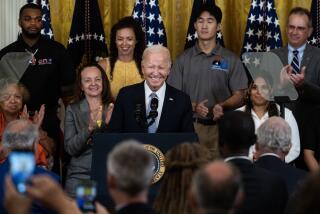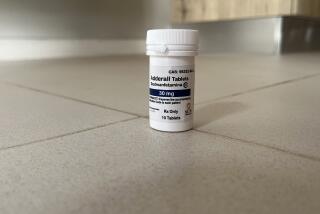Public Faces Overdose of Similar Drug Names : Health: Proliferation of new brands means big money is on the line for competing pharmaceutical companies, but confusion can be fatal for patients.
- Share via
Quick, what was that prescription your father takes for his ulcer? Zantac? Xanax? Zenate?
Or that heart drug your uncle takes. Cardizem? Procardia? Cardura? Or that new breast cancer drug, Taxol--or was it Paxil?
Pharmaceutical makers seem intent on tying the American tongue with brand names that defy linguistic logic and often look and sound like one another. While other new product names are designed to be memorable, drug companies seem to live in a nether world of pharmo-jargon founded by ancient Greeks and populated only by doctors and druggists.
It’s not just confusing--it’s also dangerous. Misunderstandings over names have led to fatal mistakes in prescriptions.
Drug makers say they want names that are easy to remember, pronounce and spell, but that it’s a difficult goal to reach.
“There are only 26 letters in the Roman alphabet and there’s a glut of trademarks,” said Marty Mazurek, a naming executive with Merck & Co., the world’s largest drug maker.
Companies also face a complex naming process, watched over by the U.S. Food and Drug Administration and trademark offices in every country where they want to sell drugs. So sometimes, even when they think they’ve found that perfect five-letter moniker, it can end up translating to something like “death” in Chinese.
As a result, finding new drug names can cost up to $200,000 and take up to four years, companies say.
“Desperation in finding a name has driven a lot of name development to very arbitrary, gibberish-type names,” said Nan Budinger, creative director of Metaphor Name Consultants in San Francisco.
*
The drug-naming process is much different than back in 1899, when scientists at Bayer AG in Germany found a new painkiller in the sap of a shrub called spiraea. They simply took the root phrase “spir,” put an “a” in front of it and an “in” in back and came up with aspirin.
Now the process begins years before the drug is sold, while scientists are still testing it in humans.
First, international groups develop a generic name for the drug. This is the name that will apply to the chemical compound no matter which company makes it.
Drug company naming committees include doctors, pharmacists, linguists, marketers, researchers and even English teachers. They start with hundreds of candidates from a computerized random name generator or those they dream up on their own.
The namers pick out those easiest to say and spell and discard those that are too similar to existing drugs or those with unwanted meanings in English or other languages. Then they’re reviewed by government regulators.
Since 1990, the FDA has been the final name arbiter, further weeding out look-alike names and those with too much marketing “puffery,” like Fatoff or Getwell, said Yana Mille, a labeling regulator.
“ ‘Wonder’ has been used and accepted as the name of a bread, but it is not an acceptable name for a drug,” she told a trademarks conference in May. The FDA has rejected a third of all names.
For instance, the FDA rejected the name Regaine for Upjohn’s hair restoration drug, but approved Rogaine.
Traditionally, many drug names have Greek or Latin roots. “Zo,” for example, is a Greek prefix meaning life, “pro” is Greek and Latin for before, or in front of. “Bene” means well.
These help the drugs sound medicinal, a key ingredient. Without it, “People say, ‘That doesn’t sound like a legitimate drug. That sounds like a candy drug,’ ” said Clive Chajet of Lippincott & Margulies Inc., a corporate identity consultant.
*
Some drug makers, like the Swiss company Sandoz AG, use their corporate name: Sandimmune, Sanorex, Sansert.
Biotech drugs, developed from genetic engineering, can be often be spotted with “bio,” “gen,” or “cell” in their names.
John Montgomery, Warner-Lambert Co.’s drug naming chief, said companies often want to describe the drug or what it does in the trademark.
For example, Cognex increases cognition in Alzheimer’s disease patients. Pepcid is for peptic ulcers. Halcion, a sleeping pill, is reminiscent of halcyon, the mythological Greek bird that calmed the seas. Premarin, for post-menopausal pain, is made from pregnant mares’ urine.
Neurontin treats neurons or nerve cells to prevent epileptic seizures. Estroderm is a patch that secretes the hormone estrogen through the skin.
*
Unfortunately, catchy phrases get overused. So, Cardura for high blood pressure sounds like Cardizem and Procardia for heart patients.
Some companies prefer nonsense words because they’re less likely to cause a trademark conflict. Many began relying on the letters X and Z because they stand out from others, but they’ve become overused too. So there’s Zantac for ulcers, Xanax for anxiety and Zenate, a vitamin supplement.
The results of this confusion can be harrowing.
In 1992, the wife of a New York State appeals court judge died after a hospital that should have given her Paraplatin, a Bristol-Myers Squibb drug for ovarian cancer, instead gave her Platinol, a different cancer drug.
Two years earlier, doctors were about to do exploratory surgery on a Colorado glaucoma patient who had consistently low blood sugar levels. The night before, they checked her medication and found that she had been given Diabinese, a drug for diabetics, instead of the glaucoma drug, Diamox. Because of her bad vision, she couldn’t tell them apart on the label.
Merck had to rename its ulcer drug Losec to Prilosec because some patients were getting the fluid reduction drug Lasix instead. The confusion was blamed for at least one death.
This August, Daniels Pharmaceuticals Inc. promised to change the name of its thyroid drug, Levoxine, because pharmacists were giving people Wellcome’s heart drug Lanoxin.
A nonprofit group, the Institute for Safe Medication Practices in Huntingdon Valley, Pa., has found hundreds of “mixed-up pairs” and publishes articles warning professionals about them.
Its president, Michael Cohen--a drug-naming consultant--said doctors can help avoid confusion by typing prescriptions instead of scribbling and indicating what condition a drug is being prescribed to treat, such as Paxil for depression.
Druggists also need to talk more to their customers, he said. “Tell the patient, this is your Seldane, it’s an antihistamine. If the patient was told to take Feldene for arthritis, they’ll say, ‘Wait a minute.’ ”
More public awareness of different drugs and what they do would also help, experts say.
More to Read
Inside the business of entertainment
The Wide Shot brings you news, analysis and insights on everything from streaming wars to production — and what it all means for the future.
You may occasionally receive promotional content from the Los Angeles Times.










